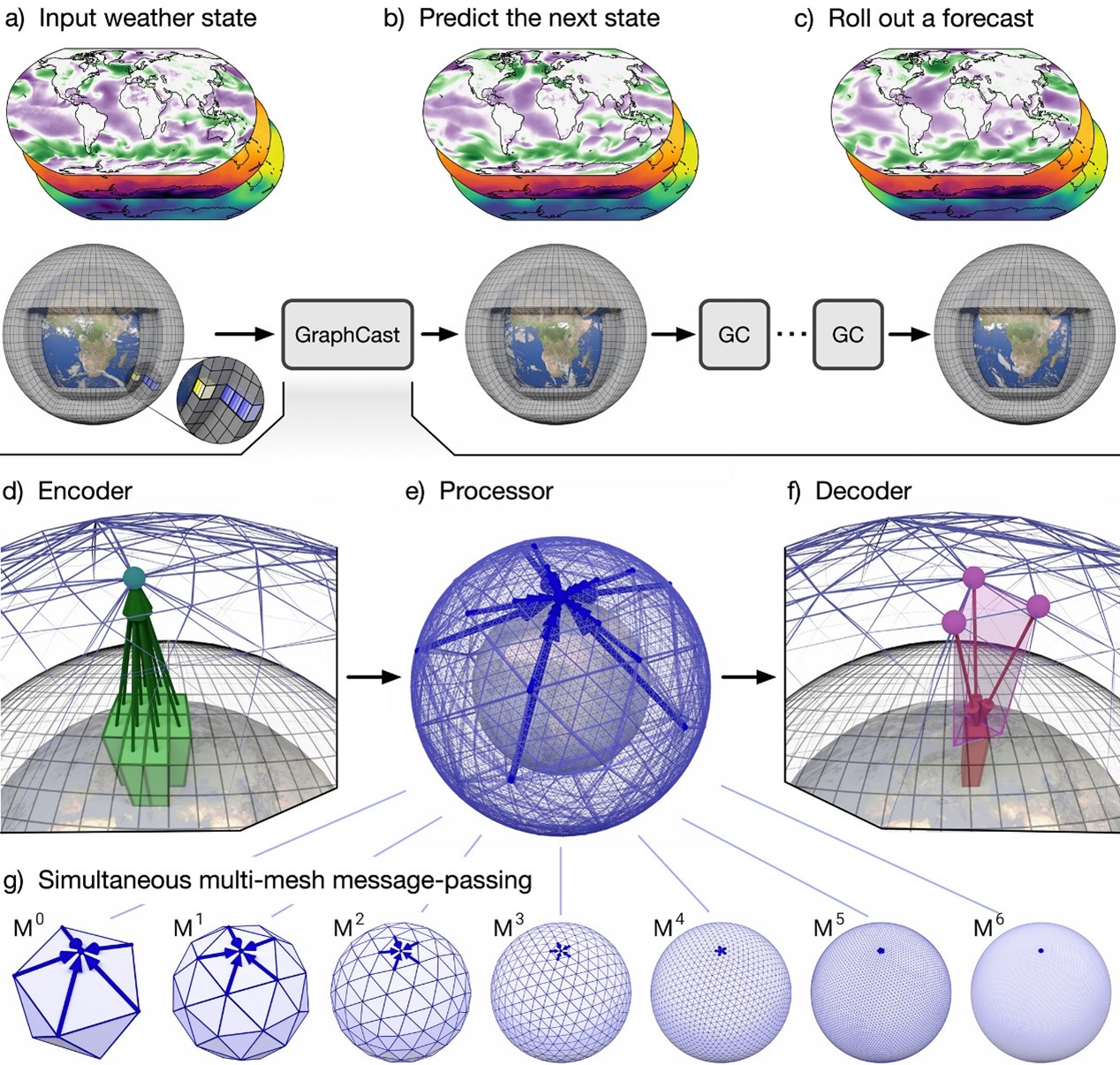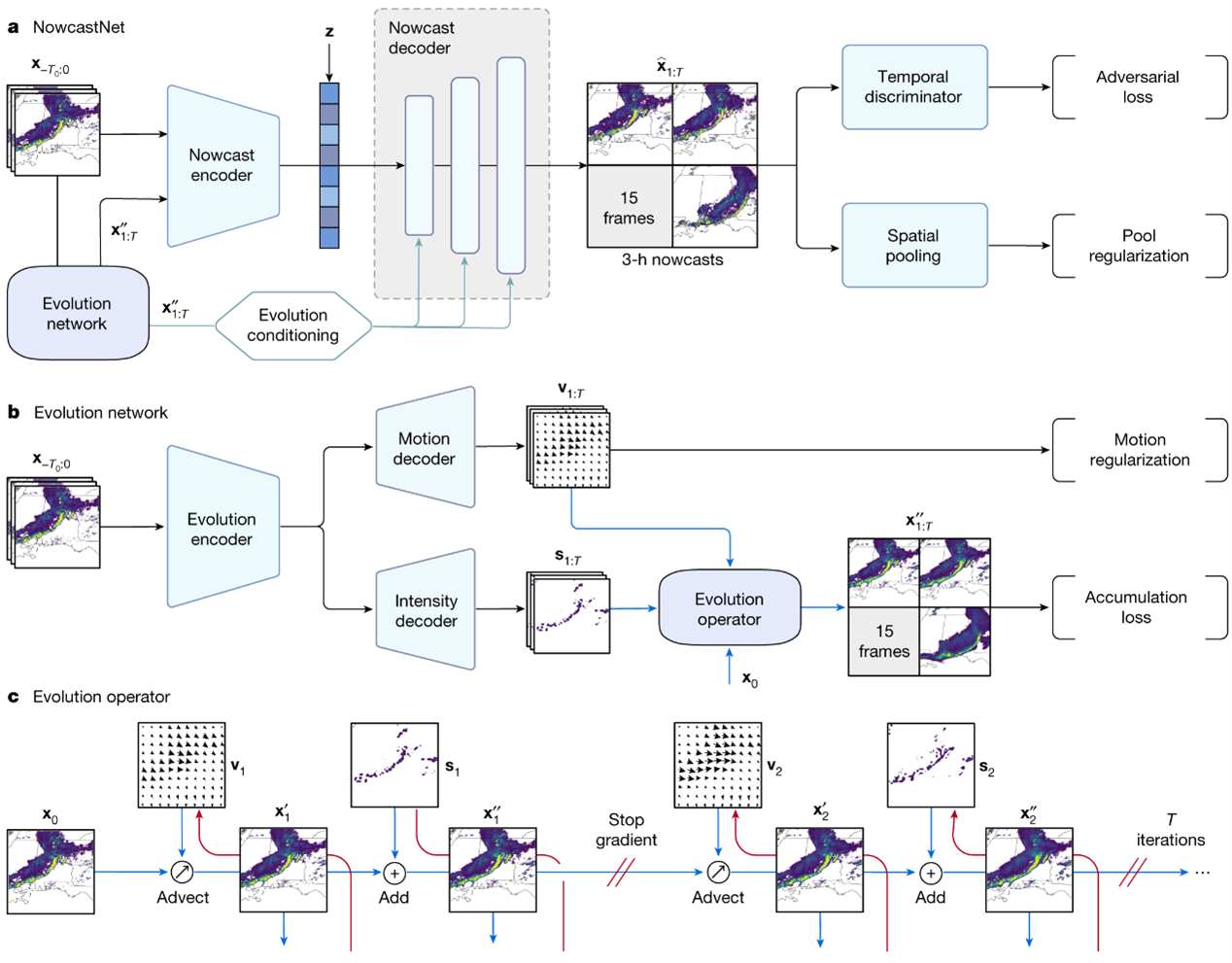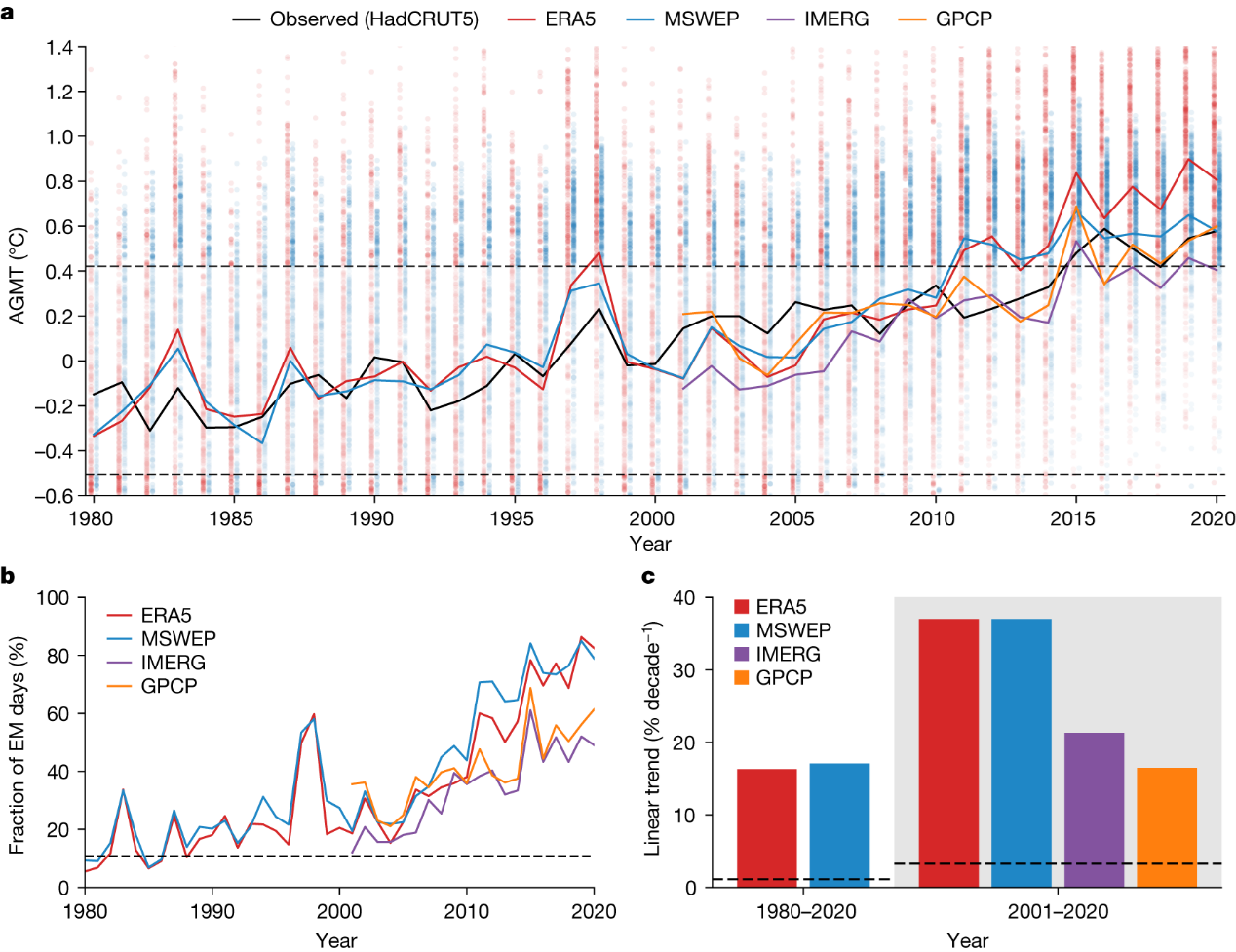热点文献带您关注AI在气候领域的最新进展——图书馆前沿文献专题推荐服务(85)
2024-01-08

本期我们为您选取了4篇文献,介绍AI在气候领域的最新发展前沿,包括Google GraphCast基于机器学习精准预测未来10天全球天气情况、华为盘古气象利用3D神经网络进行精确的中期全球天气预报、NowcastNet对极端降水的临近预报、通过深度学习揭示全球变暖对日降水量的影响。

Learning skillful medium-range global weather forecasting
Lam, Remi, etc.
SCIENCE, 2023, 382(6672)
Global medium-range weather forecasting is critical to decision-making across many social and economic domains. Traditional numerical weather prediction uses increased compute resources to improve forecast accuracy, but does not directly use historical weather data to improve the underlying model. Here, we introduce “GraphCast,” a machine learning-based method trained directly from reanalysis data. It predicts hundreds of weather variables, over 10 days at 0.25° resolution globally, in under one minute. GraphCast significantly outperforms the most accurate operational deterministic systems on 90% of 1380 verification targets, and its forecasts support better severe event prediction, including tropical cyclones tracking, atmospheric rivers, and extreme temperatures. GraphCast is a key advance in accurate and efficient weather forecasting, and helps realize the promise of machine learning for modeling complex dynamical systems.
阅读原文:https://www.science.org/doi/10.1126/science.adi2336

Model schematic

Accurate medium-range global weather forecasting with 3D neural networks
Bi, Kaifeng, etc.
NATURE, 2023, 619(7970): 533–538
Weather forecasting is important for science and society. At present, the most accurate forecast system is the numerical weather prediction (NWP) method, which represents atmospheric states as discretized grids and numerically solves partial differential equations that describe the transition between those states. However, this procedure is computationally expensive. Recently, artificial-intelligence-based methods have shown potential in accelerating weather forecasting by orders of magnitude, but the forecast accuracy is still significantly lower than that of NWP methods. Here we introduce an artificial-intelligence-based method for accurate, medium-range global weather forecasting. We show that three-dimensional deep networks equipped with Earth-specific priors are effective at dealing with complex patterns in weather data, and that a hierarchical temporal aggregation strategy reduces accumulation errors in medium-range forecasting. Trained on 39 years of global data, our program, Pangu-Weather, obtains stronger deterministic forecast results on reanalysis data in all tested variables when compared with the world's best NWP system, the operational integrated forecasting system of the European Centre for Medium-Range Weather Forecasts (ECMWF). Our method also works well with extreme weather forecasts and ensemble forecasts. When initialized with reanalysis data, the accuracy of tracking tropical cyclones is also higher than that of ECMWF-HRES.
阅读原文:https://www.nature.com/articles/s41586-023-06185-3


Skilful nowcasting of extreme precipitation with NowcastNet
Zhang, Yuchen, etc.
NATURE, 2023, 619(7970): 526–532
Extreme precipitation is a considerable contributor to meteorological disasters and there is a great need to mitigate its socioeconomic effects through skilful nowcasting that has high resolution, long lead times and local details. Current methods are subject to blur, dissipation, intensity or location errors, with physics-based numerical methods struggling to capture pivotal chaotic dynamics such as convective initiation and data-driven learning methods failing to obey intrinsic physical laws such as advective conservation. We present NowcastNet, a nonlinear nowcasting model for extreme precipitation that unifies physical-evolution schemes and conditional-learning methods into a neural-network framework with end-to-end forecast error optimization. On the basis of radar observations from the USA and China, our model produces physically plausible precipitation nowcasts with sharp multiscale patterns over regions of 2,048 km × 2,048 km and with lead times of up to 3 h. In a systematic evaluation by 62 professional meteorologists from across China, our model ranks first in 71% of cases against the leading methods. NowcastNet provides skilful forecasts at light-to-heavy rain rates, particularly for extreme-precipitation events accompanied by advective or convective processes that were previously considered intractable.
阅读原文:https://www.nature.com/articles/s41586-023-06184-4


Anthropogenic Fingerprints in Daily Precipitation Revealed by Deep Learning
Ham, Yoo-Geun, etc.
NATURE, 2023, 622(7982): 301–307
According to twenty-first century climate-model projections, greenhouse warming will intensify rainfall variability and extremes across the globe. However, verifying this prediction using observations has remained a substantial challenge owing to large natural rainfall fluctuations at regional scales. Here we show that deep learning successfully detects the emerging climate-change signals in daily precipitation fields during the observed record. We trained a convolutional neural network (CNN) with daily precipitation fields and annual global mean surface air temperature data obtained from an ensemble of present-day and future climate-model simulations. After applying the algorithm to the observational record, we found that the daily precipitation data represented an excellent predictor for the observed planetary warming, as they showed a clear deviation from natural variability since the mid-2010s. Furthermore, we analysed the deep-learning model with an explainable framework and observed that the precipitation variability of the weather timescale (period less than 10 days) over the tropical eastern Pacific and mid-latitude storm-track regions was most sensitive to anthropogenic warming. Our results highlight that, although the long-term shifts in annual mean precipitation remain indiscernible from the natural background variability, the impact of global warming on daily hydrological fluctuations has already emerged.
阅读原文:https://www.nature.com/articles/s41586-023-06474-x
联系人:杨老师 闫老师
邮箱:yandong80@bupt.edu.cn
电话:西土城校区图书馆125室 62281933 62283502
沙河校区图书馆东205室 66605330 66605331
往期精彩推荐
热点文献带您关注通信领域的最新进展——图书馆前沿文献专题推荐服务(84)
热点文献带您关注AI与集成电路领域的最新进展——图书馆前沿文献专题推荐服务(83)
热点文献带您关注AI大型语言模型的最新进展——图书馆前沿文献专题推荐服务(82)
热点文献带您关注通信领域的最新进展——图书馆前沿文献专题推荐服务(81)
热点文献带您关注半导体领域的最新进展——图书馆前沿文献专题推荐服务(80)
热点文献带您关注AI领域的最新进展——图书馆前沿文献专题推荐服务(79)
热点文献带您关注通信领域的最新进展——图书馆前沿文献专题推荐服务(78)
热点文献带您关注半导体领域的最新进展——图书馆前沿文献专题推荐服务(77)
热点文献带您关注AI Transformer的最新进展——图书馆前沿文献专题推荐服务(76)
热点文献带您关注低轨卫星通信技术的最新进展——图书馆前沿文献专题推荐服务(75)
热点文献带您关注惯性测量单元的最新进展——图书馆前沿文献专题推荐服务(74)
热点文献带您关注存算一体技术的最新进展——图书馆前沿文献专题推荐服务(73)
热点文献带您关注电子皮肤的最新进展——图书馆前沿文献专题推荐服务(72)
热点文献带您关注AI的最新进展——图书馆前沿文献专题推荐服务(71)
热点论文带您探索未来网络中使用的新材料以及相关技术 ——图书馆前沿文献专题推荐服务(70)
热点文献带您关注AI图神经网络的最新进展——图书馆前沿文献专题推荐服务(69)
热点论文带您探索新型网络架构以及超材料在未来通信中的应用——图书馆前沿文献专题推荐服务(68)
热点文献带您关注AI深度强化学习的最新进展——图书馆前沿文献专题推荐服务(67)
热点论文带您探索新型网络架构以及超表面在未来通信中的应用——图书馆前沿文献专题推荐服务(66)
热点文献带您关注AI领域的最新进展——图书馆前沿文献专题推荐服务(65)
热点论文带您领略半导体领域的最新进展——图书馆前沿文献专题推荐服务(64)
热点文献带您关注AI领域的最新进展——图书馆前沿文献专题推荐服务(63)
热点论文带您探索智能化以及超表面在未来通信中的应用——图书馆前沿文献专题推荐服务(62)
热点文献带您关注AI领域的最新进展——图书馆前沿文献专题推荐服务(61)
热点论文带您领略未来通信研究热点的最新进展——图书馆前沿文献专题推荐服务(60)
热点文献带您关注AI深度学习的最新进展——图书馆前沿文献专题推荐服务(59)
热点论文带您领略未来通信热点技术的最新进展——图书馆前沿文献专题推荐服务(58)
热点文献带您关注AI视频动作识别的最新进展——图书馆前沿文献专题推荐服务(57)
热点论文带您领略新材料半导体领域的最新进展——图书馆前沿文献专题推荐服务(56)
热点文献带您关注AI深度神经网络的最新进展——图书馆前沿文献专题推荐服务(55)
热点论文带您领略未来通信在新材料技术领域的最新进展——图书馆前沿文献专题推荐服务(54)
热点文献带您关注AI在光神经网络领域的最新进展——图书馆前沿文献专题推荐服务(53)
热点论文带您领略半导体领域的最新进展——图书馆前沿文献专题推荐服务(52)
热点文献带您关注AI在集成电路领域的最新进展——图书馆前沿文献专题推荐服务(51)
热点论文带您领略光电半导体领域的最新进展——图书馆前沿文献专题推荐服务(50)
热点文献带您关注AI与人脸识别——图书馆前沿文献专题推荐服务(49)
热点论文带您领略未来通信在新材料技术领域的最新进展——图书馆前沿文献专题推荐服务(48)
热点文献带您关注AI与生物学——图书馆前沿文献专题推荐服务(47)
热点论文带您领略未来通信在光电材料及信息编码领域的最新进展——图书馆前沿文献专题推荐服务(46)
热点文献带您关注AI与医学图像——图书馆前沿文献专题推荐服务(45)
热点论文带您领略未来通信在材料领域研究的最新进展——图书馆前沿文献专题推荐服务(44)
热点文献带您关注AI与医学研究——图书馆前沿文献专题推荐服务(43)
热点论文带您领略未来通信在海空领域研究的最新进展——图书馆前沿文献专题推荐服务(42)
热点文献带您关注AI视觉跟踪——图书馆前沿文献专题推荐服务(41)
热点论文与带您领略5G相关领域研究的最新进展——图书馆前沿文献专题推荐服务(40)
热点文献带您关注AI技术的最新进展——图书馆前沿文献专题推荐服务(39)
热点论文与带您领略5G/6G领域热点研究的最新进展——图书馆前沿文献专题推荐服务(38)
热点文献带您关注AI与边缘计算——图书馆前沿文献专题推荐服务(37)
热点论文与带您领略5G/6G基础研究的最新进展——图书馆前沿文献专题推荐服务(36)
热点文献带您关注AI强化学习——图书馆前沿文献专题推荐服务(35)
热点论文与带您领略未来通信的热点技术及最新进展——图书馆前沿文献专题推荐服务(34)
热点文献带您关注AI深度学习与计算机视觉——图书馆前沿文献专题推荐服务(33)
热点论文与带您领略5G/6G热点技术的最新进展——图书馆前沿文献专题推荐服务(32)
热点文献带您关注AI与触觉传感技术——图书馆前沿文献专题推荐服务(31)
热点论文与带您领略5G/6G热点技术的最新进展——图书馆前沿文献专题推荐服务(30)
热点文献带您关注AI与机器人——图书馆前沿文献专题推荐服务(29)
热点论文与带您领略5G/6G电子器件和太赫兹方面的最新进展——图书馆前沿文献专题推荐服务(28)
热点文献带您关注AI自动驾驶——图书馆前沿文献专题推荐服务(25)
热点论文与带您领略5G/6G通信器件材料的最新进展 ——图书馆前沿文献专题推荐服务(24)
热点文献带您关注机器学习与量子物理 ——图书馆前沿文献专题推荐服务(23)
热点论文与带您领略6G网络技术的最新发展趋势 ——图书馆前沿文献专题推荐服务(22)
热点文献带您关注模式识别——图书馆前沿文献专题推荐服务(21)
热点论文与带您领略5G/6G材料技术的最新发展——图书馆前沿文献专题推荐服务(20)
热点文献带您关注图神经网络——图书馆前沿文献专题推荐服务(19)
热点论文带您领略5G/6G的最新技术动向 ——图书馆前沿文献专题推荐服务(18)
热点文献带您关注AI主动视觉——图书馆前沿文献专题推荐服务(17)
热点论文与带您领略5G/6G的最新技术演进 ——图书馆前沿文献专题推荐服务(16)
热点文献带您关注AI计算机视觉 ——图书馆前沿文献专题推荐服务(15)
热点论文与带您领略5G/6G的硬科技与新思路 ——图书馆前沿文献专题推荐服务(14)
热点文献带您关注AI机器翻译 ——图书馆前沿文献专题推荐服务(11)
热点论文:5G/6G引领社会新进步——图书馆前沿文献专题推荐服务(10)
热点文献带您关注AI文本摘要自动生成 ——图书馆前沿文献专题推荐服务(9)
热点论文带您探究6G的无限可能——图书馆前沿文献专题推荐服务(8)
热点文献带您关注AI情感分类技术 ——图书馆前沿文献专题推荐服务(7)
热点论文带您探究5G和未来通信材料技术领域 ——图书馆前沿文献专题推荐服务(6)
前沿文献带您解读自然语言处理技术 ——图书馆前沿文献专题推荐服务(5)
热点论文带您探究5G和未来通信——图书馆前沿文献专题推荐服务 (4)
热点论文解读AI应用领域 ——图书馆前沿文献专题推荐服务(3)
